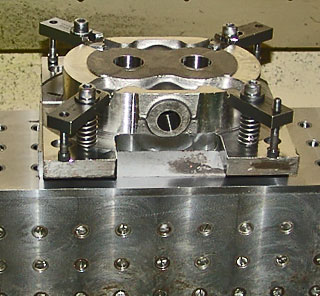Glossary H – M
Hardenability
In steels, the property that determines the depth and distribution of hardness induced by quenching.
Hardness
Resistance of a metal to plastic deformation, usually by indentation. Indentation hardness may be measured by various hardness tests, such as Brinell, Rockwell, and Vickers.
Heat-affected zone
That portion of the base metal that was not melted during brazing, cutting, or welding, but whose microstructure and mechanical properties were altered by the heat.
Heat-resisting Alloy
An Alloy developed for very high temperature service where relatively high stresses are encountered and where oxidation resistance is frequently required.
Heat treatment
Heating and cooling a solid metal or Alloy in such a way as to obtain desired conditions or properties.
Homogenizing
Holding at a temperature to decrease or eliminate chemical segregation by diffusion.
Hot isostatic pressing
A process for simultaneously heating and forming a part by subjecting it to equal pressure from all directions at a high temperature. “HIPing”
Hot topping
An exothermic or insulating powder applied to the top of the metal in an open riser just after pouring to increase the riser’s effectiveness.
ICI
Investment casting Institute
Impact energy
The amount of energy required to fracture a material, usually measured by means of an Izod or Charpy test.
Impregnation
The treatment of porous parts with a sealing medium to stop pressure leaks, usually done under pressure.
Inconel
A trade name for a series of oxidation-resistant Alloys, 80% Ni, 14% Cr, and 6% Fe.
Intercrystalline
Between the crystals, or grains, of a metal. Itergranular corrosion occurring preferentially at grain boundaries.
Intermetallic Compound
An intermediate phase in an Alloy system having relatively simple stoichiometric proportions and is usually brittle.
Interpass temperature
In a multipass weld, the lowest temperature of a pass before the succeeding one is commended.
Investment casting Process
A casting process in which a wax or thermoplastic pattern is used. The pattern is invested (surrounded by) refractory slurry. After the mold is dry, the pattern is melted or burned out, and molten metal is poured into the resulting cavity.
ISO 9000
A quality assurance model made up of quality system requirements. This model may be applied to organizations that produce, install, and service products. ISO expects organizations to apply this model, and to meet these requirements, by developing a quality system.
Izod test
A pendulum-type, single-blow impact test in which the specimen, usually notched, is fixed at one end and broken by a falling pendulum. The energy absorbed, as measured by the subsequent rise of the pendulum, is a measure of impact strength or notch toughness.
Keel block
A standard test casting consisting of a rectangular bar that resembles the keel of a boat, attached to the bottom of a large riser, or shrinkhead. Test specimens are machined from the rectangular bar; the shrinkhead is discarded.
Kerf
The width of the cut produced during a cutting process.
KSI
Kilo-pounds per square inch. A kilo-pound is 1000 pounds.
Ladle
A receptacle used for transferring and pouring molten metal.
Liquid penetrant inspection
A type of nondestructive inspection that locates discontinuities that are open to the surface of a metal by first allowing a penetrating dye to infiltrate the discontinuity, removing the excess penetrant, and then applying a developing agent that causes the penetrant to seep back out of the discontinuity and register as an indication. Liquid penetrant inspection is suitable for both ferrous and nonferrous materials, but is limited to the detection of open surface discontinuities in nonporous solids.
Liquidus
In a constitution or equilibrium diagram, the line representing the temperatures at which the various compositions in the system begin to freeze on cooling or finish melting on heating.
Macroetching
Etching a metal surface to accentuate gross structural details for observation by the unaided eye or at low magnifications.
Macrostructure
The structure of metals as revealed by macroscopic examination of the etched surface of a polished specimen.
Manganese
An element added to steel to form Mn sulfide, thus reducing the undesirable effect of iron sulfide. It is added to Stainless steels as a substitute for nickel, and to increase the solubility of nitrogen in nitrogen-Alloyed grades. Element 25; Symbol: Mn.
Martensite
The hardest microstructure that can be formed in a carbon or Alloy steel. It is characterized by an acicular pattern in the microstructure in both ferrous and nonferrous Alloys.
Metallography
The science dealing with the constitution and structure of metals and Alloys as revealed by the unaided eye or by such tools as low-powered magnification, optical microscopy, electron microscopy, and x-ray diffraction techniques.
Metallurgy
The science and technology of metals and their ores and Alloys. Process metallurgy is concerned with the extraction of metals from their ores and with refining of metals; physical metallurgy with the physical and mechanical properties of metals as affected by composition, processing, and environmental conditions; and mechanical metallurgy with the response of metals to applied forces.
Microstructure
The structure of metal and Alloy specimens as revealed by polishing and etching and examining the prepared surface using a microscope.
Modulus of elasticity
A measure of the rigidity of metal. It is the ratio of stress to the corresponding strain within the proportional limit. For carbon and low Alloy steels of any composition and treatment, the value is approximately 29,000,000 psi. Also called the “elastic modulus” and “coefficient of elasticity.”
Molybdenum
A metal used widely in Alloying of other metals. It is added to Stainless steels and nickel-based Alloys to increase resistance to pitting and crevice corrosion. It is used as a hardening element for steel and to impart red hardness to the steel. Element 42; Symbol: Mo.

